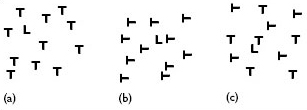3.3 Non-target effects
Treisman's feature integration theory has been very influential, but it does not appear to explain all experimental observations, and there have been alternative accounts of the feature-binding process. Duncan and Humphreys (1989) reported effects which do not fit too well within the basic Treisman account. They required participants to search for the letter ‘L’ (the target) within a number of ‘Ts’ (the non-targets). You may get a feel for the relative difficulty of different versions of their task by examining Figure 6.

The task can be conceptualised as looking for two lines that meet at a corner (the L), rather than forming a T-junction. It should not make much difference whether the T-junctions are vertical or horizontal (as in Figure 6a and 2.6b), and, indeed, the search times for these two sorts of display are similar. However, when the Ts are mixed, as in Figure 6c, it takes longer to find the target. This finding would not have been predicted by a simple feature integration theory. Duncan and Humphreys (1989) argued that part of finding the target actually involves rejecting the non-targets and that this is a harder task when they come in a greater variety.
This explanation does not rule out the idea that features need to be integrated to achieve recognition, but it does suggest that non-targets, as well as targets, need to be recognised. The following section also describes evidence that non-targets are recognised, but in this case the recognition appears to take place in parallel.
